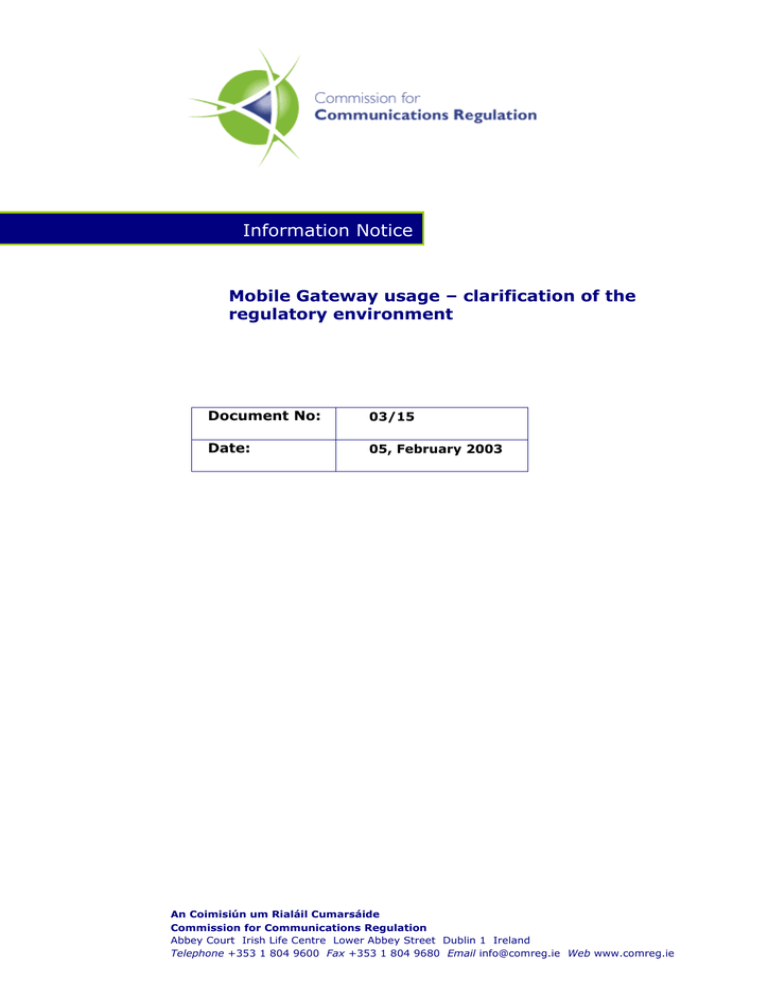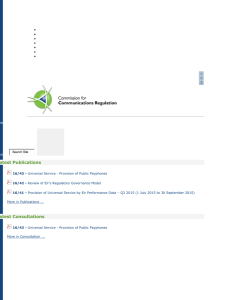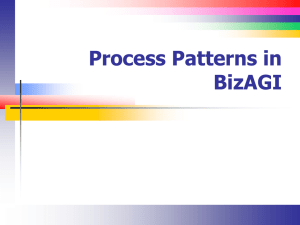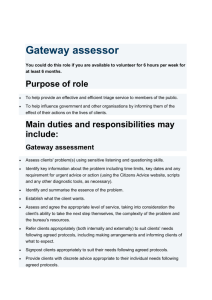Information Notice Mobile Gateway usage – clarification of the regulatory environment
advertisement

Information Notice Mobile Gateway usage – clarification of the regulatory environment Document No: 03/15 Date: 05, February 2003 An Coimisiún um Rialáil Cumarsáide Commission for Communications Regulation Abbey Court Irish Life Centre Lower Abbey Street Dublin 1 Ireland Telephone +353 1 804 9600 Fax +353 1 804 9680 Email info@comreg.ie Web www.comreg.ie Mobile Gateway Usage – Clarification of the regulatory environment Contents 1 Introduction .................................................................................... 2 2 Consumer and Business Usage of Gateways ......................................... 3 2.1 IMPLICATIONS OF CONSUMER AND BUSINESS USAGE OF GATEWAYS ............................4 2.1.1 Technical / Quality of Service Implications ...........................................4 2.1.2 Regulatory Implications – Licensing of Apparatus..................................5 2.1.3 Potential for Discriminatory Pricing .....................................................5 2.2 COMREG’S POSITION – CONSUMER AND BUSINESS USAGE OF GATEWAYS ......................5 3 Operator usage of gateways............................................................... 7 3.1 IMPLICATIONS OF OPERATOR USAGE OF GATEWAYS ...............................................7 3.1.1 Quality of Service.............................................................................7 3.1.2 Presentation of CLI...........................................................................8 3.1.3 Other Licence Conditions...................................................................9 3.2 COMREG POSITION ....................................................................................9 4 Conclusions ................................................................................... 10 4.1 COMREG’S POSITION ON THE USAGE OF GATEWAYS ............................................. 10 Appendix 1 ......................................................................................... 11 1 ComReg 03/15 Mobile Gateway Usage – Clarification of the regulatory environment 1 Introduction Radio spectrum is a finite resource and ComReg is responsible for ensuring that it is used efficiently to meet current and future demand. ComReg also has broad responsibilities to ensure that Licensed Operators provide high quality and price-competitive services to the public. These responsibilities are central to the topic of this Information Notice, which deals with devices that are currently being used in the Irish marketplace to enable fixed telephone networks to connect directly to mobile networks via a mobile telephony radio link. These devices are commonly referred to as Mobile Gateways or GSM Gateways (since GSM is the mobile technology currently used in Ireland), although the principles equally apply to other forms of mobile network technology. However, the development of new technology does not take place in isolation from the regulatory framework and competitive processes. This Information Notice therefore provides further details about potential usage of GSM Gateways by end users or by telecoms operators and presents the broad implications of their use in both situations. The paper additionally clarifies the regulatory environment for these devices by presenting ComReg’s position in relation to the usage of these devices in both scenarios. 2 ComReg 03/15 Mobile Gateway Usage – Clarification of the regulatory environment 2 Consumer and Business Usage of Gateways Gateways are essentially mobile terminals that have been adapted for use in non-mobile situations to substitute for fixed line connections. Such products are typically mains powered and often have sockets to allow standard fixed handsets, fax machines and modems to be attached. An additional antenna can often also be attached to improve reception in areas with poor coverage. Such products are often used as a form of Wireless Local Loop for applications such as:• temporary or mobile office applications - e.g. exhibitions • situations where there is no fixed line connection available - e.g. boats, building sites • telemetry - e.g. vending machines, alarm monitoring For telemetry applications, advances in technology will mean that GSM and other radio technology modules will continue to develop and become smaller, eventually becoming compact enough to be integrated into almost any kind of fixed electronic device. Separate to these WLL and telemetry applications, GSM Gateways are also promoted for private commercial use to business customers as a means for their staff to save money on calls from private fixed lines to mobile phones. A PABX1 can be programmed to automatically route calls dialled to mobile numbers from any extension via a connected GSM Gateway, thereby attracting a lower mobile-to-mobile ‘on-net’ rate. The Gateway contains Subscriber Identity Modules (SIMs) - typically for a number of networks. The Gateway (or a similar set-up using several Gateway devices and intelligence in the PABX) recognises a mobile endpoint2, selects a SIM to correspond, and sets up the call. The call effectively originates from another mobile on the same network as the called party, so it enjoys a cheaper call rate. The purpose of the Gateway is therefore to avoid the higher charges of fixed-line-to-mobile calls (since it bypasses the PSTN) and exploit the lower tariff of mobile-to-mobile calls within the same network, i.e. ‘on-net’ calls. Similarly, inbound calls from mobile phones can be completed via a Gateway to the PABX if the ‘on-net’ rate is lower than the mobile-to-fixed rate. 1 Private Automatic Branch eXchange – an automatic telephone switching system for providing access to the public telephone system. A PABX usually serves a single commercial entity and is located on its premises. 2 Note that with the introduction of full MNP, it will become increasingly inaccurate to rely on the 08X prefix to identify the appropriate Irish network on which a call will be terminated. 3 ComReg 03/15 Mobile Gateway Usage – Clarification of the regulatory environment 2.1 Implications of Consumer and Business Usage of Gateways The consumer advantages of being able to use such devices for WLL-type applications are obvious, and business use of Gateways increases choice and lowers the costs of telecommunications. However, the usage of Gateways has technical / quality of service, regulatory and pricing implications, considered below. 2.1.1 Technical / Quality of Service Implications The technical implications for the majority of cases of consumer or business use of Gateways are minimal. For the WLL and telemetry applications, the Gateway is effectively a mobile terminal being used for a fixed application and should not pose any particular problems for mobile network operators if small numbers of the devices are located in any particular radio Cell. For business use, a set-up with an unusually large number of Gateway devices could potentially pose capacity problems for a mobile network operator in the Cell in which the business is located, potentially impacting on the integrity and grade of service being offered. However, ComReg understands that mobile operators are currently accepting and connecting customers with such equipment, and therefore mobile operators might reasonably be expected to provide additional capacity to accommodate the extra traffic. Alternatively, mobile operators may also choose to contractually limit customer capacity on these WLL-type devices in order to ensure that the integrity and quality of the network is maintained for mobile users. In any case, the concept of a large company using the efficiency of a central mobile gateway in combination with its own PABX makes business sense and is not logically different (at the public network interface) from providing each of its employees with an individual mobile handset. Calls originating from a Gateway are similar to those originating from a PABX, and the Calling Line Identification (CLI) of the SIM provided for that Gateway can be presented to the called party, although users always have the choice to block the sending of the CLI. Since a PABX is a private telecommunications system, there does not appear to be any manipulation of CLI taking place if a call originating on a private internal extension is routed directly via the Gateway onto a public mobile network and displays the Gateway SIM’s CLI. Furthermore it should also be possible for a called party to return a call to the displayed CLI provided by a Gateway, leaving the PABX to route the call appropriately within the business – e.g. to Reception. In this manner, it appears that no law enforcement3 issues are raised, since the call is traceable back to the company’s business premises. 3 There are conditions in fixed and mobile operators’ licences to provide for call tracing / legal interception for law enforcement purposes. 4 ComReg 03/15 Mobile Gateway Usage – Clarification of the regulatory environment 2.1.2 Regulatory Implications – Licensing of Apparatus The ODTR issued an order in 1997 exempting mobile telephones from individual licences. The Wireless Telegraphy Act, 1926 (Section 3) (exemption of Mobile Telephones) Order, 1997, contains a definition for a ‘Mobile Telephone’ as ‘apparatus for wireless telegraphy capable of originating and receiving a call’ and a ‘Call’ is defined as ‘a telephone call or other communication of any kind made or sent wholly or partly on a GSM or TACS mobile telephony network’. Given these definitions, ComReg considers that Gateways fall under this Exemption. 2.1.3 Potential for Discriminatory Pricing In Part 3 of the Mobile Telecommunications Licence, additional licence conditions (in addition to the various EU and national legislation) are outlined for mobile operators with SMP in the relevant market. These conditions refer, inter alia, to undue preference (Clause 16.1), unfair discrimination (Clause16.2) and unfair cross-subsidisation (Clause 11). Mobile operators with SMP in the relevant market are required to comply with these conditions in their retail offerings to Gateway users. As Gateways may generate substantial volumes of traffic on a mobile network, mobile operators may offer certain Gateway users favourable retail rates for ‘on-net’ calls. However, unduly discriminating between ‘on-net’ and ‘off-net’ calls may tip the market in favour of a particular network. Mobile operators should be aware of their regulatory obligations and offer appropriate retail rates that are transparent and non-discriminatory. If necessary, ComReg would investigate cases of potential discrimination to determine the compliance of mobile operators. 2.2 ComReg’s Position – consumer and business usage of Gateways ComReg understands that there are savings to be made at certain time periods, e.g. peak time, by using Gateways instead of making fixed-to-mobile calls. These savings are likely to apply to both eircom customers and Indirect Access /CPS operators for peak times, as mobile termination rates are higher than the price of an ‘on-net’ call for this time period. Since mobile termination charges are a significant proportion of the cost of fixed-to-mobile calls, any mobile termination rate reductions (or rebalancing of ‘on-net’ and ‘off-net’ mobile retail charges) will decrease the attractiveness of Gateways. In short, it is ComReg’s opinion that the arbitrage opportunity and thus the potential growth for Gateways in Ireland is not as significant as that in other countries where there is a greater price differential between the cost of ‘on-net’ mobile and fixed-to-mobile calls. From a service quality perspective, private use of Gateways is not a matter of concern to ComReg. Large business Gateway installations would be generally known to mobile operators, who can take necessary measures – preferably by 5 ComReg 03/15 Mobile Gateway Usage – Clarification of the regulatory environment increasing Cell capacity but potentially by contractually limiting customer capacity to these ‘WLL-type’ devices in order to ensure that the service integrity and quality of the network is maintained for mobile users. Where large-volume Gateway systems might impact on network planning, mobile operators could require users to declare such use before installation to allow for network configuration. However, until such time as mobile operators have clear policies about the use of Gateways, customers intending to make use of large Gateway installations are advised to contact their mobile network operator(s) prior to installation to discuss these issues. Based on the WT Exemption Order for mobile phones, ComReg considers Gateways to be licence-exempt - in line with mobile handsets - and therefore do not need individual licences under any new licensing scheme. 6 ComReg 03/15 Mobile Gateway Usage – Clarification of the regulatory environment 3 Operator usage of gateways ComReg is aware that some fixed network operators wish to use Gateway devices as a link from their own network to mobile network(s) to carry thirdparty traffic. ComReg assumes that a fixed or mobile operator would consider using Gateway devices to avoid the up-front capital cost and administrative burden of establishing a proper wired interconnection path (although this would need to be balanced against the cost of the Gateway devices themselves). In general, there are small savings to be made when comparing mobile termination rates with retail ‘on-net’ mobile rates for traffic at peak times. However, given the relatively small price differential between the cost of retail ‘on-net’ mobile calls and wholesale mobile termination rates, it is questionable whether operator use of Gateways could become prevalent in Ireland, particularly when compared to other countries where the potential for such arbitrage activity is greater due to larger savings. Nevertheless, there are service quality and potentially law enforcement issues raised by public operator use of Gateway devices as a proxy for a proper interconnection set-up. These are discussed in the next section and an example of some of the specific issues caused by use of Gateways in this manner is provided in Appendix 1. 3.1 Implications of Operator usage of Gateways There are several issues with operator usage of Gateway devices as a proxy for interconnection from a regulatory perspective: 3.1.1 Quality of Service If an operator using a Gateway has a call that is due to terminate on a mobile network, a second call is set up from the Gateway and the two calls are conferenced. This has obvious service quality implications – e.g. if the first call originated on a mobile network, then there are three legs of the call that use the air interface, and voice quality will suffer since the air interface has bandwidth limitations and is subject to interference from other users. Calling parties may also notice an increase in call establishment timescales. Some consumers would be prepared to accept diminished service quality if there were cost savings for the calling party, but it would not necessarily be the case that savings would be passed on. Where a call originates on another network and the operator making use of the Gateway is transiting the call, the calling party is still likely to be charged the normal retail rates by the originating network for a call to a mobile phone, yet is likely to be provided with an inferior service. A specific example of this is illustrated in Appendix 1. 7 ComReg 03/15 Mobile Gateway Usage – Clarification of the regulatory environment In addition to diminishing the quality of the voice path, a very large public network Gateway could lead to diminished service quality to other users of the Cell where the Gateway is located and could ultimately compromise network integrity. Additional Cell capacity can be added, but there are technical limitations to the ultimate capacity of a Cell4. An operator using a Gateway set-up in this manner would have a standard retail contract with the mobile operator in order to be provided with service for the SIMs in the Gateway devices. An Irish mobile operator may refuse to continue the provision of the licensed service under Section 2.2 of its licence, to or from Network Termination Points and/or terminal equipment where the mobile operator finds that such termination points and/or terminal equipment are being used for activities which lead to a material breach of its licence obligations – e.g. quality of service parameters or legal interception requirements contained in licence conditions. 3.1.2 Presentation of CLI Another specific service quality issue connected with operator usage of Gateways is that an incorrect CLI may be presented to the called party. Alternatively, the operator using the Gateway may block the sending of the CLI altogether, despite individual callers wishing to have their CLI displayed. By using a Gateway to terminate a call on a mobile network, it will be the Gateway’s CLI - not the CLI of the original calling party - that will be passed to the mobile network and onwards to the called party. Condition 6.10 of the current Mobile and Condition 6.85 of the General Telecommunications Licences6 allow the Commission to direct on the provision of CLI for the purposes of protecting the interests of users. ComReg considers that this misrepresentation of the calling party is a breach of licence for the operator using the Gateway. This breach flows through to the terminating mobile operator’s licence, since it is effectively being caused by the Gateway operator acting as retail customer in this situation, and the Mobile operator could disconnect this customer under Section 2.2. Since there are effectively two calls back-to-back, this set-up could also interfere with an operator’s ability to establish and maintain the capability to intercept messages and to provide information regarding the use of the service 4 An additional Cell can be provided but this brings other difficulties for the network operator concerned such as planning permission for a new site, frequency re-use of radio spectrum – a mobile operator is more likely to be driven to refuse access or to come to a special agreement for direct interconnection. 5 Although these are licence conditions under the current licensing framework, ComReg considers that similar conditions would be contained in any new authorisations scheme based on the EC Authorisation Directive (2002/20EC). 6 The activity of carrying and switching third-party nationally or internationally originated traffic for termination on an Irish Mobile network is generally licensable, as are any other voice service activities that would require an interconnection with a mobile operator. 8 ComReg 03/15 Mobile Gateway Usage – Clarification of the regulatory environment (Section 6.3 – in the General Licence, Section 6.4 in the Mobile licence), which could also be a breach of licence for the operator using the Gateway and by implication, the terminating mobile operator. 3.1.3 Other Licence Conditions There are additional conditions that are of some relevance. For example, section 6.3 of the Mobile licence (Section 6.2 of the General licence) requires the mobile operator to prevent a customer from using its network in a manner which could prevent the mobile operator from ensuring the accuracy and reliability of any systems, equipment, data or procedures used by them to measure or to track the provision of Licensed Services. Such activities are likely to be affected by the unanticipated use of a Gateway in the call path. 3.2 ComReg Position Use of Gateways as a proxy for a proper interconnection path leads to reduced service quality, potential presentation of incorrect CLI and potential to interfere with call tracing / legal interception. Since such occurrences would be breaches of an operator’s licence, ComReg cannot support use of Gateways in this manner. Furthermore, one of the objectives of ComReg is to protect consumers in their dealings with telecoms suppliers. This includes the protection of customers against deterioration in service quality, particularly if the customer is paying for a higher level of service quality. Since several operators may be involved in delivering a call, it is not guaranteed that any cost savings made by one operator in the chain using a Gateway would be passed on to consumers. In certain circumstances (e.g. roaming mobile customers) any savings are guaranteed not to be passed on, but call quality will be affected. Additionally, it might be noted that since the potential cost savings between retail ‘on-net’ and mobile termination rates are small and are primarily available at peak times, it is questionable whether an arbitrage opportunity or any scope to provide lower cost calls even exists in the Irish market. Therefore, taking into account the licence framework as set out above and the consumer protection issues, ComReg’s position is that operator use of Gateways as a form of interconnection is not acceptable and operators should establish proper interconnection paths, either directly with mobile operators or indirectly via a transit operator such as eircom, in order to provide appropriate service quality levels to consumers and to meet licence conditions. Finally, mobile operators are reminded that legitimate requests for interconnection must always be entertained. 9 ComReg 03/15 Mobile Gateway Usage – Clarification of the regulatory environment 4 Conclusions 4.1 ComReg’s position on the usage of Gateways This Information Notice presented ComReg’s position on:• Consumer and business usage of Gateways; and • Operator usage of Gateways. Consumer and Business usage of gateways With regard to the consumer and business usage of gateways, ComReg’s position is that Gateways will be licence-exempt, as ComReg considers that gateways fall under ‘The Wireless Telegraphy Act, 1926 (Section 3) (exemption of Mobile Telephones) Order, 1997’. Additionally, ComReg accepts that mobile operators may define policies which contractually limit customer capacity of these ‘WLL-type’ Gateway devices in order to ensure that the service integrity and quality of the network is maintained for mobile users. ComReg may review such policies to ensure that these limitations are reasonable, proportionate and non-discriminatory. Operator usage of gateways With regard to the operator usage of gateways, ComReg’s position is that the use of Gateways as a form of interconnection is not acceptable and operators should establish proper interconnection paths, either directly with mobile operators or indirectly via a transit operator such as eircom, in order to provide appropriate service quality levels to consumers and to meet licence conditions. Mobile operators should carry out the necessary enforcement procedures to ensure that the usage of Gateways is in compliance with ComReg’s position. Such enforcement can be carried out in line with Section 2.2 of the Mobile Telecommunications Licence. Where a dispute arises about the usage of Gateways, ComReg will consider taking action in accordance with its powers to ensure that Irish telecommunications users continue to be provided with quality services. 10 ComReg 03/15 Mobile Gateway Usage – Clarification of the regulatory environment Appendix 1 The diagram below illustrates some of the issues around an operator using a Gateway set-up as a proxy for either direct interconnection between the operator’s own switch and the mobile operator’s switch (MSC), or an interconnection with a transit operator such as eircom, who would onward route the call appropriately. Calling party 08X XXX XXXX Call from 08X YYY YYYY Called Party Call 2 – Gateway Base Station 08X YYY YYYY The ‘Gateway Operator’ Direct Interconnection Transit (e.g. via eircom) Mobile operator’s MSC eircom The diagram portrays one possible call situation. The Calling Party (with a mobile phone number 08X XXX XXXX) is roaming abroad and makes a call to the Called Party – a mobile customer in Ireland. The call originates on a foreign mobile network and via a transit arrangement where the ‘Gateway Operator’ is paid to deliver the call, arrives in Ireland at the ‘Gateway operator’s’ switch. The calling party is charged the standard retail roaming charge by their home network. Rather than using a standard interconnection path, the ‘Gateway operator’ initiates a second mobile call via a Gateway (with a number 08X YYY YYYY) to the Called Party. This second call again goes over the air interface in the Cell where the Gateway is located and is delivered to the Called Party, who receives the Gateway’s CLI, assuming that the ‘Gateway Operator’ hasn’t blocked it (in which case no CLI is available). The Calling party may perceive a delay in call establishment time and both parties are likely to perceive poor voice quality, since there are three elements of the call path using an air interface. If law enforcement agencies were monitoring the activities of the Calling Party, they would have difficulty establishing the full details of the call in this scenario. 11 ComReg 03/15






